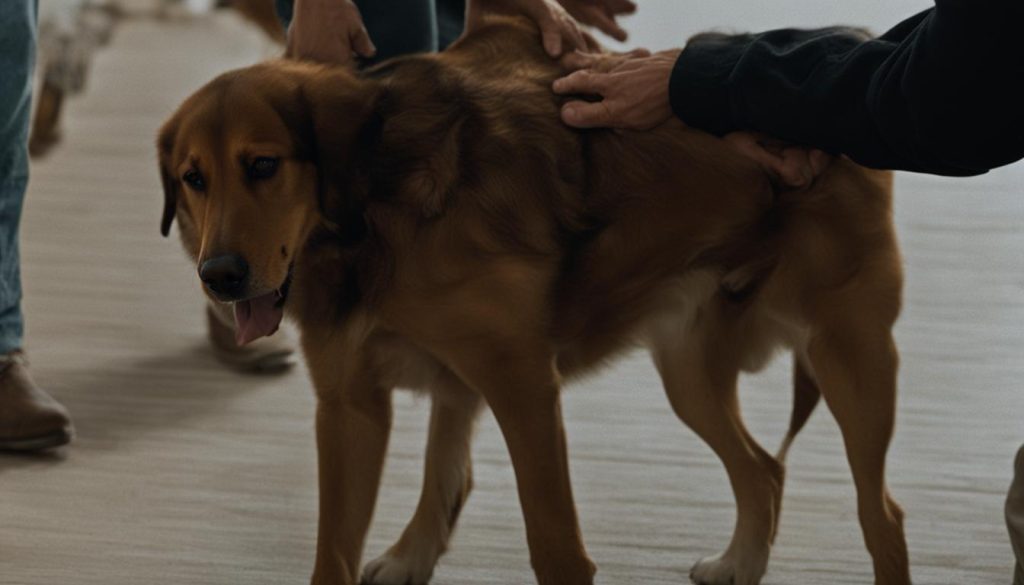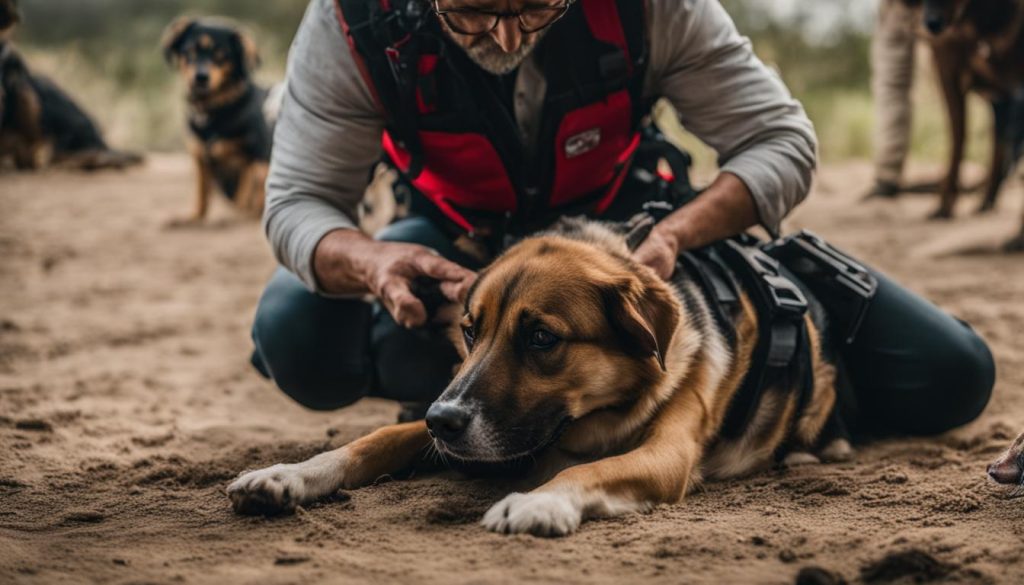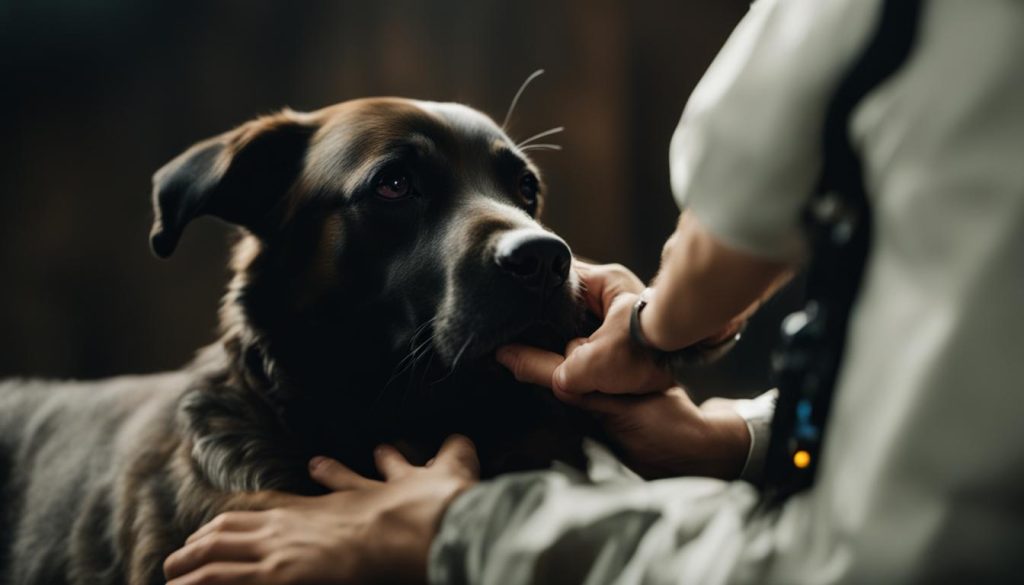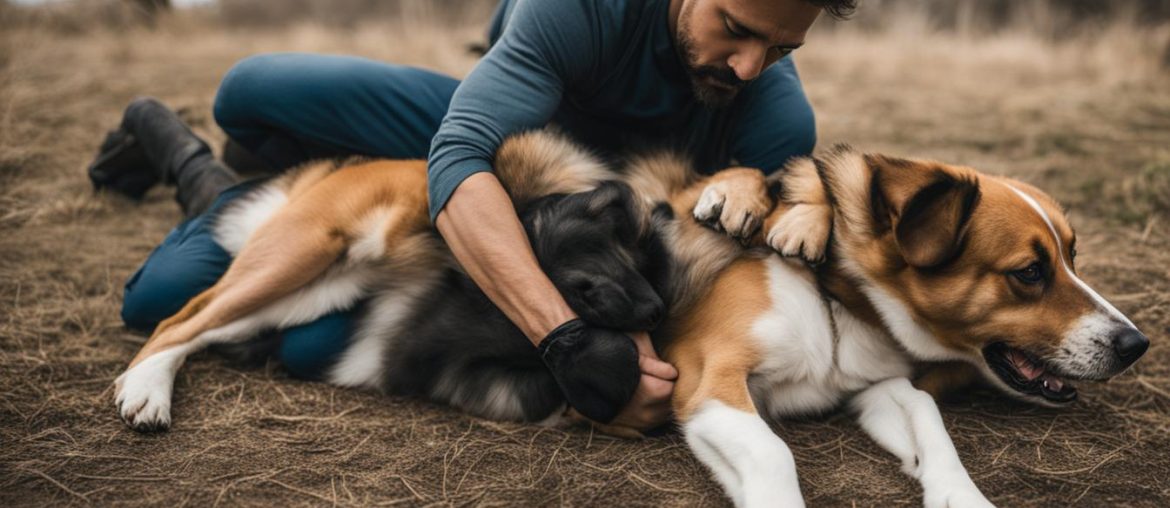Performing CPR on a dog is a critical skill that every pet owner should know. In emergency situations where a dog is not breathing or does not have a heartbeat, CPR can be the difference between life and death for your furry friend. By quickly and correctly administering artificial respirations and chest compressions, you can help restore oxygen to vital organs and improve the chances of a positive outcome.
Key Takeaways:
- Learn how to perform CPR on a dog to save their life in emergency situations.
- Administer artificial respirations and chest compressions to restore oxygen to vital organs.
- Act quickly and appropriately to prevent brain damage and organ failure.
- Check the airway, breathing, and heartbeat as part of the first response maneuvers.
- Understand the modified Heimlich maneuver for dogs with obstructed airways.
What is Dog CPR?

Dog CPR is a life-saving procedure that aims to restore oxygen to a dog’s vital organs when their heart stops beating or they stop breathing. Similar to human CPR, dog CPR involves artificial respirations and chest compressions. The process is crucial in emergency situations to prevent brain damage and organ failure. Acting quickly and appropriately can make all the difference in saving your furry friend’s life.
To perform dog CPR, it’s important to follow established guidelines and instructions. The process involves assessing the dog’s condition, providing rescue breaths to open the air passages, and administering chest compressions to stimulate the heart. Performing these steps correctly can help maintain oxygen circulation and increase the chances of successful resuscitation. It is important to remember that dog CPR is not a substitute for professional veterinary care, but it can provide crucial support until help arrives.
Dog CPR Process
- Assess the situation and ensure your own safety
- Check if the dog is responsive and breathing
- If the dog is unresponsive, check for a pulse
- If there is no pulse, position the dog for rescue breathing
- Cover the dog’s nose and mouth with your mouth and give two rescue breaths
- Perform chest compressions by applying force to the chest at a rate of 100-120 compressions per minute
- Continue the cycle of rescue breaths and chest compressions until the dog shows signs of breathing or professional help arrives
Remember, performing dog CPR requires proper training and knowledge. It is highly recommended to take a certified pet first-aid course to learn the correct techniques and procedures. Being prepared can make a significant difference in emergency situations, potentially saving your beloved pet’s life.
Different First Response Maneuvers
As the first responder in an emergency situation involving your dog, there are important steps you can take before and during transportation to a veterinary facility. These first response maneuvers can help stabilize your dog and increase their chances of survival. Remember, professional help should be sought immediately, but these measures can make a difference in the critical moments before help arrives.
1. Checking the Airway
First, ensure that your dog’s airway is clear. Look inside their mouth to check for any foreign objects or obstructions. If you see something blocking the airway, carefully try to remove it using a pair of tweezers or your fingers. Be cautious not to push the object further down the throat.
2. Determining Breathing
Next, assess if your dog is breathing. Watch for any rise and fall of their chest or listen for breath sounds. If your dog is not breathing, you will need to perform rescue breathing to provide artificial respiration.
3. Checking for a Heartbeat
Lastly, check for a heartbeat. Place your hand on the left side of your dog’s chest, just behind the elbow, to feel for any signs of a heartbeat. If there is no heartbeat, you will need to perform chest compressions in addition to rescue breathing.
Remember, these first response maneuvers are not a substitute for professional veterinary care. They are temporary measures to support your dog’s vital functions until you can reach a veterinary professional. Stay calm, act quickly, and seek immediate medical assistance for your furry friend.
Heimlich Maneuver on Dogs

If a dog is choking and unable to breathe due to an obstructed airway, quick action is crucial. One technique that can be used in this situation is the Heimlich maneuver. This modified version of the Heimlich maneuver is specifically designed for dogs and can help dislodge the object causing the obstruction. However, it is important to approach this maneuver with caution to avoid causing any further harm to the dog.
To perform the Heimlich maneuver on a dog, follow these steps:
- Position the dog: Make sure the dog is standing or lying on its side. If possible, have someone hold the dog to keep them steady.
- Locate the ribcage: Feel for the dog’s ribcage, which is located just behind the front legs and slightly below the heart.
- Apply pressure: Using both hands, make a fist and place it just behind the ribcage. Firmly press inward and upward with quick thrusts. Be careful not to press too hard or in the wrong place, as this can cause injury to the dog.
- Check the airway: After each thrust, check to see if the object has been dislodged. If not, continue with the thrusts until the object is expelled or until veterinary help arrives.
It is important to note that the Heimlich maneuver should only be used if the dog is conscious and unable to breathe due to an obstructed airway. If the dog is unconscious or not breathing at all, CPR should be administered instead. Additionally, it is always recommended to seek immediate veterinary attention after performing any first aid maneuvers on a dog.
| Signs a dog may be choking: | Signs a dog’s airway is clear: |
|---|---|
| Difficulty breathing or gasping for air | Clear and unobstructed breathing |
| Pawing at the mouth or throat | Normal breathing sounds |
| Excessive drooling | Normal heart rate |
| Panic or distress | Responsive and alert |
Knowing how to perform the Heimlich maneuver on a dog can potentially save their life in a choking emergency. However, it is important to remember that this technique should only be used when necessary and with caution. Always consult with a veterinarian for proper guidance and training in first aid techniques for dogs.
How to Do CPR on a Dog

In the event of an emergency where your dog’s heart has stopped beating or they have stopped breathing, knowing how to perform CPR on a dog can be life-saving. Dog cardiopulmonary resuscitation (CPR) involves a combination of rescue breaths and chest compressions to restore oxygen to vital organs. Here’s a step-by-step guide on how to perform CPR on a dog:
Step 1: Position the Dog
First, position the dog for rescue breathing by aligning their head with the back and tilting it back slightly to open the air passages. This helps facilitate the flow of air into the lungs during rescue breaths.
Step 2: Give Rescue Breaths
Cover the dog’s nose and mouth with your mouth and give rescue breaths to provide artificial respiration. Ensure a proper seal and watch for the chest to rise as you deliver each breath. Give two breaths initially, each lasting about one second.
Step 3: Perform Chest Compressions
After delivering the rescue breaths, move on to chest compressions. Place the heel of one hand on the dog’s rib cage, just behind the front legs. Interlock your other hand on top for added pressure. Compress the chest to about one-third to one-half the depth of the chest, allowing it to fully recoil between compressions.
Step 4: Repeat the Cycle
Continue the cycle of rescue breaths and chest compressions. Give two rescue breaths followed by 15 chest compressions for larger dogs, and two breaths followed by 10 compressions for smaller dogs. Repeat this cycle until the dog starts breathing on its own or professional help arrives.
Performing CPR on a dog is a critical skill that can make all the difference in an emergency. Remember to periodically check if the dog has started breathing again and adjust your CPR accordingly. Always seek immediate veterinary attention, even if the dog appears to be recovering.
Assessing the Dog during CPR

During the process of performing CPR on a dog, it is crucial to periodically assess the dog’s condition and response to the procedures being carried out. Assessing the dog allows you to gauge whether the CPR is effective and whether any adjustments need to be made.
One important aspect to assess is whether the dog has started breathing again. Every two minutes, pause the rescue breaths and chest compressions to check if the dog is breathing on its own. If the dog has resumed breathing, it is a positive sign that the CPR is working. However, if the dog is still not breathing, continue with the rescue breaths and chest compressions until professional help arrives.
Additionally, it is essential to monitor other vital signs during the assessment. Observe the dog’s heart rate, pulse, and overall responsiveness. Assess if there are any changes in color or temperature of the gums. These indicators can provide valuable insights into the dog’s condition and help guide the ongoing CPR.
Warning Signs to Look Out For:
- Rapid deterioration in the dog’s condition
- No improvement in breathing or heartbeat
- Changes in the dog’s color, such as pale or bluish gums
- Severe bleeding that cannot be controlled
- Any signs of neurological distress, such as seizures
Remember, assessing the dog during CPR is crucial to ensure that appropriate actions are taken. By monitoring the dog’s response and adjusting the CPR as necessary, you can provide the best chance of survival until professional help arrives.
Signs Your Dog May Need Emergency Care

In certain situations, dogs may require immediate medical attention. Recognizing the signs of a dog health emergency is crucial for pet owners. Here are some common signs that indicate your dog may need emergency care:
- Rapid breathing: If your dog is breathing heavily or struggling to catch its breath, it could indicate a serious respiratory issue.
- Pale gums: If your dog’s gums appear pale or white instead of their normal pink color, it may be a sign of a lack of oxygen or blood circulation.
- Weak pulse: A weak or irregular pulse can be a sign of a cardiovascular problem or shock.
- Change in body temperature: Sudden increase or decrease in body temperature can indicate heatstroke, hypothermia, or other serious conditions.
- Trouble standing: If your dog is suddenly unable to stand or walk, it could be a sign of a neurological or musculoskeletal issue.
- Apparent paralysis: Partial or complete loss of movement in any part of the body may indicate a serious spinal cord or nerve problem.
- Loss of consciousness: If your dog faints or loses consciousness, it requires immediate medical attention.
- Seizures: Seizures can be a sign of an underlying medical condition and require immediate veterinary care.
- Excessive bleeding: Uncontrolled bleeding, whether from an injury or internally, necessitates emergency medical attention.
- Uncharacteristic aggressive behaviors: If your dog suddenly becomes aggressive or exhibits unusual behavior, it may indicate pain or stress.
Remember, these signs are general indicators of a potential health emergency, and it is essential to consult a veterinarian for a proper diagnosis and treatment plan.
Emergency First Aid
While awaiting veterinary assistance, take appropriate emergency first aid measures to stabilize your dog’s condition. Keep your dog calm and immobilized, and avoid administering any medications without professional guidance. Maintain a safe and comfortable environment for your dog until you can transport them safely to a veterinary facility.
| Emergency | Response |
|---|---|
| Difficulty breathing | Ensure the airway is clear and administer rescue breaths if necessary. |
| Unresponsive or unconscious | Perform CPR if there is no heartbeat or breathing. |
| Bleeding | Apply direct pressure to the wound using a clean cloth or bandage. |
| Seizures | Protect the dog from injury by clearing the surrounding area and providing a soft surface. |
| Heatstroke | Cool the dog down by applying wet towels or moving them to a shaded area. |
It is important to remember that these first aid measures are temporary and should not replace professional veterinary care. Promptly seek the assistance of a veterinarian for a comprehensive evaluation and treatment of your dog’s condition.
Basic First-Aid at Home

As a responsible pet owner, it is important to be prepared for emergencies and have basic first-aid knowledge to provide immediate care for your dog. While professional veterinary care should always be sought, there are several first-aid treatments you can administer at home to help stabilize your dog’s condition before getting them to a veterinarian.
Common Dog First Aid Treatments
Here are some essential first-aid treatments you can apply to your dog:
- External Bleeding: Apply firm pressure to the wound using a clean cloth or bandage to minimize bleeding. Elevate the wounded area if possible.
- Heatstroke: If your dog is suffering from heatstroke, move them to a cool, shaded area and wet their fur with cool water. Use a fan or air conditioning to lower their body temperature gradually.
- Skin Exposure to Hazardous Materials: If your dog’s skin comes into contact with hazardous substances, rinse the affected area with lukewarm water for at least 10 minutes. Contact your veterinarian for further guidance.
- Seizures: During a seizure, ensure your dog is in a safe space and remove any objects that may cause injury. Do not attempt to restrain or hold down your dog during the seizure. Keep track of the duration and intensity of the seizure for your veterinarian.
- Shock: If your dog is in shock due to an injury or trauma, keep them warm and comfortable. Elevate their hindquarters slightly to improve blood flow to vital organs. Do not give them any food or water until you have consulted with a veterinarian.
Remember, these treatments are temporary measures to stabilize your dog’s condition. It is crucial to seek professional veterinary care as soon as possible to ensure a proper diagnosis and appropriate treatment for your furry friend.
| First-Aid Treatment | Instructions |
|---|---|
| External Bleeding | Apply firm pressure to the wound with a clean cloth or bandage. Elevate the wounded area if possible. |
| Heatstroke | Move your dog to a cool, shaded area. Wet their fur with cool water and use a fan or air conditioning to gradually lower their body temperature. |
| Skin Exposure to Hazardous Materials | Rinse the affected area with lukewarm water for at least 10 minutes. Contact your veterinarian for further guidance. |
| Seizures | Ensure your dog is in a safe space. Remove any objects that may cause injury. Do not attempt to restrain or hold down your dog. Keep track of the duration and intensity of the seizure. |
| Shock | Keep your dog warm and comfortable. Elevate their hindquarters slightly. Do not give them any food or water until you have consulted with a veterinarian. |
Remember, providing first aid is not a substitute for professional veterinary care. Always consult a veterinarian for proper diagnosis and treatment of your dog’s condition.
Emergency Plan for Dogs: Preparedness for Pet Emergencies
As a responsible pet owner, it is crucial to have an emergency plan in place for your beloved dog. Just like humans, dogs can experience unexpected emergencies that require immediate attention and care. By being prepared and having a well-thought-out plan, you can ensure that you can act swiftly and effectively in any emergency situation.
Creating an emergency plan for your dog involves several important steps. First and foremost, identify potential risks and hazards in your home or surrounding environment that could pose a threat to your dog’s safety. This could include toxic substances, dangerous plants, or escape routes.
Next, compile a list of emergency contacts, including your veterinarian’s contact information and the nearest 24/7 veterinary emergency clinic. It is also a good idea to have a backup plan in case your regular veterinarian is unavailable. Additionally, consider including the contact information of trusted friends or family members who can assist you in an emergency.
Lastly, prepare an emergency kit specifically for your dog. This kit should include essential items such as your dog’s medical records, any necessary medications, a first-aid kit, extra food and water, a leash and collar, and a familiar blanket or toy to provide comfort. Store the kit in a readily accessible location so that you can grab it quickly if needed.
By having a comprehensive emergency plan in place, you can minimize the stress and confusion that often accompanies pet emergencies. Remember to review and update your plan regularly to ensure it remains current and effective. With proper preparedness, you can provide your dog with the best possible care in times of crisis.
Dog and Cat First Aid Online Course
If you want to be better prepared to handle emergency situations and protect your furry companions, consider enrolling in the American Red Cross Cat and Dog First Aid online course. This course provides pet owners with the knowledge and skills to provide first aid care, including CPR, for their pets. By learning the proper techniques and procedures, you can potentially save your pet’s life in critical situations.
During the online course, you will gain valuable insights into pet first aid, including how to assess your pet’s condition, perform CPR, and handle various emergency situations. The course is designed to be accessible and user-friendly, allowing you to learn at your own pace and convenience. You’ll have access to interactive modules, instructional videos, and helpful resources that will guide you through the essential steps of pet first aid.
By completing the Cat and Dog First Aid online course, you’ll not only acquire the necessary skills to provide immediate care for your pets but also gain the confidence to act swiftly and effectively during emergencies. Whether you’re a pet owner, pet sitter, or animal lover, this course is a valuable investment in your pet’s well-being and safety.
| Benefits of the Cat and Dog First Aid Online Course |
|---|
| Comprehensive instruction on pet first aid techniques |
| Step-by-step guidance on CPR and other life-saving procedures |
| Interactive modules and instructional videos for effective learning |
| Flexible online access, allowing you to learn at your own pace |
| Practical resources and tools to support your learning |
| Increased confidence in handling pet emergencies |
Enroll in the Cat and Dog First Aid online course today and equip yourself with the knowledge and skills to provide immediate care for your beloved pets. By learning how to perform CPR and handle emergency situations, you can become a valuable first responder for your furry friends.
Free Dog CPR Course
If you’re a pet owner, learning how to perform CPR on a dog is a crucial skill that can potentially save your furry friend’s life in an emergency. While there are online courses available, you’ll be pleased to know that there are also free resources that can help you learn CPR for dogs. These resources can provide you with additional confidence and knowledge, ensuring you’re prepared to act swiftly and appropriately when your dog needs it most.
By taking advantage of free dog CPR courses, you can acquire the necessary skills to perform artificial respirations and chest compressions on your dog to restore their breathing and heartbeat. These courses typically cover the step-by-step process of dog CPR, including how to position the dog, deliver rescue breaths, and perform chest compressions effectively.
Remember, continuous practice and refreshment of your skills are vital to ensure you can respond confidently and correctly in an emergency. Additionally, don’t hesitate to consult with a veterinarian for proper guidance and care specific to your dog’s needs. Your dedication to learning and preparing for emergencies can truly make a difference in your pet’s life.
Table: Benefits of Taking a Free Dog CPR Course
| Benefits | Explanation |
|---|---|
| Free of charge | Access to valuable knowledge and training without any financial burden. |
| Increased confidence | Acquire the skills and knowledge necessary to handle dog CPR emergencies with confidence. |
| Quick response | Learn the step-by-step process to swiftly respond and administer life-saving measures. |
| Convenient accessibility | Access the course materials anytime, anywhere, and at your own pace. |
| Lifesaving potential | Potentially save your beloved pet’s life by knowing how to perform CPR correctly. |
Wrapping Up
In conclusion, knowing how to perform CPR on a dog is of utmost importance for any pet owner. This life-saving skill can make a significant difference in emergencies, potentially saving your furry friend’s life. By being prepared and equipped with the knowledge and skills of dog CPR, you can act swiftly and appropriately when faced with a critical situation.
Remember, time is of the essence in emergency situations. Acting quickly and seeking professional help is vital. Performing the necessary steps correctly, such as rescue breathing and chest compressions, can help restore oxygen to vital organs and prevent brain damage and organ failure.
It is crucial to continuously update your skills in pet first aid and consult with a veterinarian for proper guidance and care. They can provide valuable insights and assist in creating an emergency plan tailored to your dog’s specific needs. Being proactive and prepared can greatly improve the chances of a positive outcome in a dog CPR scenario.
FAQ
What is Dog CPR?
Dog CPR is an emergency, life-saving procedure that uses artificial respirations and chest compressions to revive a dog that is not breathing or does not have a heartbeat.
How do you perform Dog CPR?
To perform CPR on a dog, first position the dog for rescue breathing by aligning the head with the back and tilting it back slightly to open the air passages. Then, cover the dog’s nose and mouth with your mouth and give rescue breaths to provide artificial respiration. Follow this with chest compressions, aiming for about one-third to one-half the depth of the chest. Repeat the cycle of rescue breaths and chest compressions until the dog begins breathing on its own or help arrives.
How do you check if a dog is breathing?
To check if a dog is breathing, you can observe the rise and fall of their chest or feel for airflow near the nose and mouth.
What are the signs that indicate a dog may need emergency care?
Signs that indicate a dog may need emergency care include pale gums, rapid breathing, weak pulse, change in body temperature, trouble standing, apparent paralysis, loss of consciousness, seizures, excessive bleeding, and uncharacteristic aggressive behaviors.
What basic first-aid treatments can I provide for my dog at home?
Some basic first-aid treatments you can provide for your dog at home include applying pressure to external bleeding, cooling your dog during heatstroke, treating skin exposure to hazardous materials, handling seizures, and managing shock. However, it is important to consult a veterinarian as soon as possible for proper diagnosis and treatment.
How can I be prepared for emergency situations involving my dog?
It is essential to have a plan in place for emergency situations involving your dog. Consult with your dog’s veterinarian to create a plan of action in case of an emergency. Being prepared and acting quickly can greatly improve the chances of a positive outcome in a critical situation.
Are there any online courses available to learn pet first aid, including dog CPR?
Yes, the American Red Cross offers a Cat and Dog First Aid online course that provides pet owners with the knowledge and skills to provide first aid care, including CPR, for their pets.
Can I learn CPR for dogs for free?
Yes, there are free resources available to learn CPR for dogs. These resources can provide additional confidence and knowledge in case of an emergency. It is important to continuously refresh and update your skills in pet first aid.
Why is knowing how to perform CPR on a dog important?
Knowing how to perform CPR on a dog is crucial for any pet owner. It is a life-saving skill that can make a significant difference in emergencies. By being prepared, seeking professional help, and performing the necessary steps correctly, you can potentially save your dog’s life in critical situations. Remember to continuously update your skills and consult with a veterinarian for proper guidance and care.






